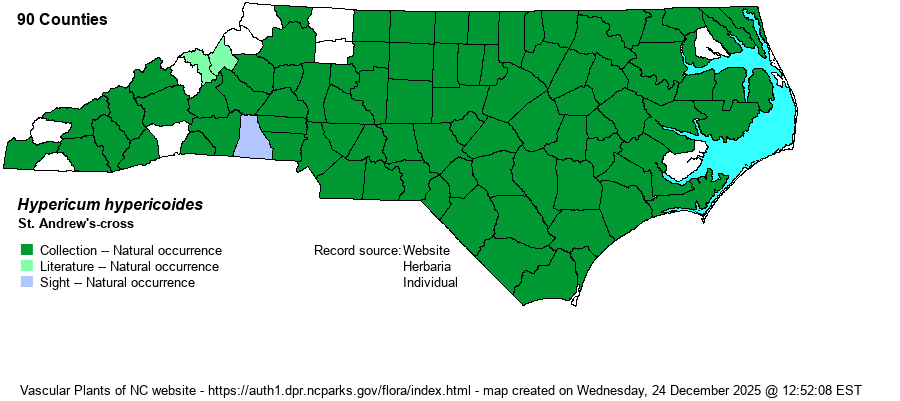| Section 6 » Order Theales » Family Hypericaceae |
Show/Hide Synonym
| taxonName | relationship | relatedTaxonName | relatedTaxonRefText | relComments |
|---|
|
|
|
|
|
|
|
|
|
|
| Hypericum hypericoides | > | Ascyrum hypericoides var. hypericoides | Fernald (1950) | | | Hypericum hypericoides | > | Ascyrum hypericoides var. hypericoides | Gleason (1952) | | | Hypericum hypericoides | > | Ascyrum hypericoides var. oblongifolium | Fernald (1950) | | | Hypericum hypericoides | > | Ascyrum hypericoides var. oblongifolium | Gleason (1952) | | | Hypericum hypericoides | = | Hypericum hypericoides ssp. hypericoides | Flora of North America (1993b, 1997, 2000, 2002a, 2002b, 2003a, 2004b, 2005, 2006a, 2006b, 2006c, 2007a, 2009, 2010) | | | Hypericum hypericoides | = | Hypericum hypericoides ssp. hypericoides | | | | Hypericum hypericoides | = | Hypericum hypericoides ssp. hypericoides | | | | Hypericum hypericoides | = | Hypericum hypericoides ssp. hypericoides | Stevens in Kubitzki, Bayer, & Stevens (2007). Key based in part on Adams (1973), Godfrey (1988), C, and GW. {add for FL: Hyperi | | | Hypericum hypericoides | = | Ascyrum hypericoides | | | | Hypericum hypericoides | > | Ascyrum hypericoides | Small (1933, 1938) | | | Hypericum hypericoides | > | Ascyrum linifolium | Small (1933, 1938) | | | Source: Weakley's Flora |
|
| Author | (L.) Crantz | |
| Distribution | Throughout the Coastal Plain and most of the Piedmont, but scattered in the Piedmont foothills and the southern half of the Mountains. Likely absent in the northern half of the Mountains. Note: The BONAP map lumps H. stragulum with H. hypericoides, and thus the entire state shows for the latter species; and there is not a map for H. stragulum.
This is a Southeastern species found north to NJ and MO and south to southern FL and central TX. It is scarce in the Appalachians, however.
| |
| Abundance | Common to very common, and quite widespread, throughout the Coastal Plain and the eastern half of the Piedmont; uncommon to fairly common in the southwestern Piedmont, but scarce in the northwestern Piedmont and southern Mountains. | |
| Habitat | This is a very familiar shrub of dry places, though not in deep sandy or overly rocky sites. It is widespread in many dry forest and woodland types, such as pine/scrub oak sandhills, pine-oak forests in the Piedmont, as well as in clearings, fields, and woodland borders. |
| Phenology | Blooms and fruits from May to August. | |
| Identification | This is a slender deciduous shrub with wide-spreading branches, growing to about 3 feet tall; the bark on older twigs is shreddy. It has narrow, oblanceolate leaves that are rounded at the tip, growing to 1-inch or less long; the bases are wedge-shaped and sessile. Typically, this erect to slightly leaning and frail-looking shrub can be identified by leaves and overall look, but the odd flowers are a give-away. The four yellow petals grow in an X-shape, rather than the standard + shape (equally spaced); the flowers tend to grow singly at the tips of branches, and thus the plant is never full of flowers. Most biologists encounter this species daily in field work in the eastern 3/4th of the state, and the only identification trouble can be with young individuals that might resemble the decumbent H. stragulum. | |
| Taxonomic Comments | Many references, especially older ones, treat this and the other 4-petaled species of Hypericum in the genus Ascyrum. Also, if H. stragulum (or A. stragulum) were included with this species, then this taxon would become H. (or A.) hypericoides var. hypericoides.
| |
| Other Common Name(s) | None | |
| State Rank | S5 | |
| Global Rank | G5 | |
| State Status | | |
| US Status | | |
| USACE-agcp | FAC link |
| USACE-emp | FACU link |

